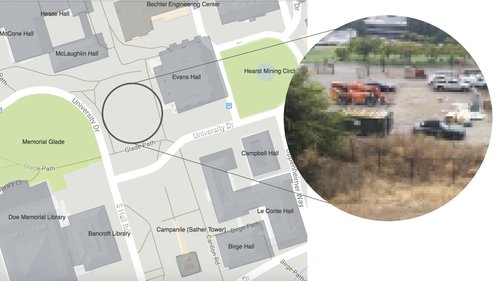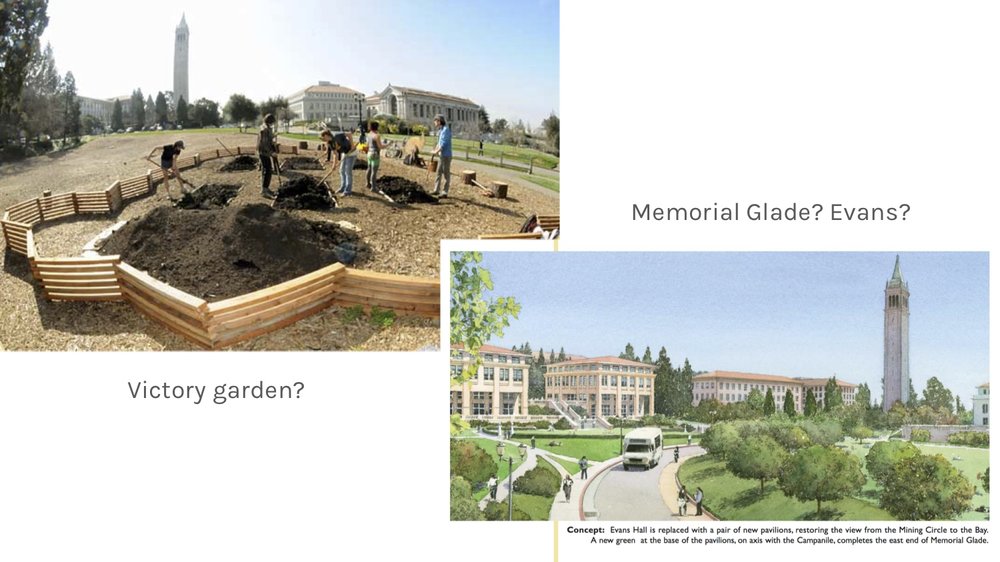Pointing to Meal Points
SOCIALLY ENGAGED ART
Keywords: Food Insecurity, Public Interactions
GOAL
To design a provocative object to engage public interactions and elicit food insecurity problems on campus.
TEAM
Jess Liu, Maisha Kabir, Evie Liu, Maggie Chen
MY ROLE
︎ Research
︎ Observation
︎ Prototyping
In the light of the opening of another new non-meal-point cafe on campus, our team decided to build a signpost with signs pointing to the food places on campus.
CONTEXT
Cal Dining, UC Berkeley’s dining program, has been shutting down on-campus cafes and services (including the popular Late Night) that accept meal points from student’s paid meal plans - despite the growing student population.
On the other hand, a plethora of new non-meal-point dining options has spawned in replacement. This has been frustrating for students, especially those who have purchased meal plans, as they struggle to find places on campus to spend their meal points. Meanwhile, students who have not purchased meal plans are also affected, as the old cafes were replaced by newer, fancier, and more costly dining options.
In the light of the opening of another new non-meal-point cafe on campus, we decided to make a signpost with signs pointing to the food places on campus, including:
Dwindling Dining Options on Campus
Cal Dining, UC Berkeley’s dining program, has been shutting down on-campus cafes and services (including the popular Late Night) that accept meal points from student’s paid meal plans - despite the growing student population.
On the other hand, a plethora of new non-meal-point dining options has spawned in replacement. This has been frustrating for students, especially those who have purchased meal plans, as they struggle to find places on campus to spend their meal points. Meanwhile, students who have not purchased meal plans are also affected, as the old cafes were replaced by newer, fancier, and more costly dining options.
In the light of the opening of another new non-meal-point cafe on campus, we decided to make a signpost with signs pointing to the food places on campus, including:
- 6 meal-point cafes (including two closed)
- 12 non-meal-point cafes on campus (excluding three more under construction).
THE SPACE
The History behind an Empty Lot
This project is about observing people in places, and this one particular space on campus really caught our attention.
It’s a construction lot just outside Evans Hall, where construction equipment is placed and trucks are parked. It seems like it’s been there forever - and nobody knows what the space is for, so we did some digging.
Turns out that it used to be a Victory Garden in 2009, brought on by an on-campus sustainability team, where healthy vines, stems, and sprouts will be the fruits of victory (we even found some pictures).
Then, at one point, there was a plan to rebuild Evans and make this lot a part of the Memorial glade.
It’s a construction lot just outside Evans Hall, where construction equipment is placed and trucks are parked. It seems like it’s been there forever - and nobody knows what the space is for, so we did some digging.
Turns out that it used to be a Victory Garden in 2009, brought on by an on-campus sustainability team, where healthy vines, stems, and sprouts will be the fruits of victory (we even found some pictures).
Then, at one point, there was a plan to rebuild Evans and make this lot a part of the Memorial glade.


OBSERVATIONS
Intrigued by this mysterious lot, our team made multiple visits to observe the space at different times and locations.
![Heat map of the traffic around the lot]()
Inside the Lot
![]()
Sounds
During one of our site observations, we saw a construction worker park in the Evans lot, and take a large piece of wood to the new cafe in front of Moffitt, which is also a no meal points location.
Intrigued by this mysterious lot, our team made multiple visits to observe the space at different times and locations.

Heat map of the traffic around the lot
General Observations
- Location: in front of the Math building and an Engineering library, so there is a lot of foot traffic
- It’s wide open, even at night: anyone can walk inside without getting into trouble
- There are high fences around the lot, so even though it’s wide open, there weren’t any student actually walking into that space, despite the amount of foot traffic around the area
- Generally quiet and unguarded, yet somehow feels forbidden
Inside the Lot

- The area is paved, and there are cars and trucks parked inside (fewer at night)
- A lot of construction materials and random trash:
- Abandoned paper signs
- Garbages
- Random things like a chair, road sign, etc.
- Smells of gasoline and oil
Sounds
- The lot is pretty quiet, but we could hear faint noises from around the lot, where there is a lot of foot traffic:
- Conversations about Engineering and Math
- Bikes being locked
- Footsteps
During one of our site observations, we saw a construction worker park in the Evans lot, and take a large piece of wood to the new cafe in front of Moffitt, which is also a no meal points location.
PROCESS
Synthesis & Reframe
Drawing from our research and site visits, we were able to make an immediate connection between the history of the site and its current state. Almost ironically, what used to be a Victory Garden that promotes sustainability and food security for students, is now a storage lot for the construction of a new cafe that doesn’t take meal-points from students.
This has led us to come to the idea of deploying a signpost at the lot to showcase the disparity between meal-point and non-meal-point dining locations on campus and highlight the problem of the increasing scarcity of affordable dining options on campus for students.
“A signpost placed in the middle of campus directs students to dining options - indicating whether or not food points may be used there. […] This work is “by the students, for the students.” In many ways, taking back the campus that belongs to you. The playfulness of this design is wonderful. “
-- Quotes from Prof. Jill Miller
Sketches

Building the Signpost
Materials
Two 2in. x 3in. x 96in. wood posts
Three pieces of plywood (for laser cutting)
Screws
White and red paint
Steps by Step Instructions
- Measure out and cut 2in. x 3in. x 96in. wood post into four 2ft. Sections
- Measure out 2inches of the end of two of the 2 ft sections
- Measure out 1.5 inches of the end of the other two 2 ft sections
- Predrill 2 holes onto the measure out ends of each section
- Predrill corresponding holes onto flat sides of wooden sections so then can attach like picture below: (show picture of base)
- Predrill 2 holes on the wider section of the wood post
- Predrill corresponding holes onto the wooden sections that have 2 inch ends
- Match 2inch end wooden sections to the corresponding side of the wood post. (Sections with 2in marked ends match with the wider side, 1.5in sections match narrower sides)
- Glue 2in section onto wood post
- Drill 2in section into wooden post
- Glue 2in end onto 1.5in end
- Drill 1.5in section into 2 in section
- Repeat steps 8-12







POST-DEPLOYMENT
Observations
We deployed the signpost at around 9AM in the morning, and we took turns to stay around it until about noon to observe people’s reactions and interactions.
Most of the time, people passed by and just ignored it. Some glanced at the sign before they continue to walk, and some circle around the sign to either read everything or take photos.
Occasionally, when a pair or a group of friends pass by, they would circle around, and even stop to converse about it. Unfortunately, while we were observing from afar, we were unable to capture these conversations, which would’ve been interesting to hear.
Before noon, two men (who seemed older than college students) came around, with clipboards in their hands. They walked up to the sign, shook it around, lifted it up, then put it back down.





People reading the signs
People taking pictures
Broken sign at night
Found broken piece next day
Then later at night, we found two of the signs on the post, True Blue and Bear’s Lair (both non-meal points), broken.
Since both of these signs were at the top of the post, which is almost impossible to break by accident without knocking off the lower signs, we concluded that the signs were most likely broken off intentionally.
One of the broken pieces wasn’t found until the next morning, by which time the entire signpost had already disappeared. We looked around the area, even in nearby dumpsters, but the post sign was nowhere to be found.
All the events described above happened within a day after our deployment of the signpost. It wasn’t clear who had broken off the pieces, stole/confiscated the signpost, and what were their motivations behind these actions.We were only left wondering:
Does a stationary sign really bother people that much?
Do people not want to talk about Cal Dining’s decisions to close their locations and reduce their service, even as the UC Berkeley population continues to grow?
Who took the signpost??
Read more about our provocation here, written by Jess.
Since both of these signs were at the top of the post, which is almost impossible to break by accident without knocking off the lower signs, we concluded that the signs were most likely broken off intentionally.
One of the broken pieces wasn’t found until the next morning, by which time the entire signpost had already disappeared. We looked around the area, even in nearby dumpsters, but the post sign was nowhere to be found.
All the events described above happened within a day after our deployment of the signpost. It wasn’t clear who had broken off the pieces, stole/confiscated the signpost, and what were their motivations behind these actions.We were only left wondering:
Does a stationary sign really bother people that much?
Do people not want to talk about Cal Dining’s decisions to close their locations and reduce their service, even as the UC Berkeley population continues to grow?
Who took the signpost??
“This piece is so successful that it was stolen. Let’s call that a compliment. ”
Read more about our provocation here, written by Jess.